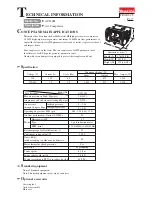
Disassembly and Reassembly
51
Connecting Rod, Piston and
Sleeve
Removal
1. Remove the cylinder heads (see “Cylinder
Head” on page 32), the discharge valve plates
(see “Discharge Valve Plates” on page 33) and
the oil sump and the oil pickup screen (see
“Oil Sump and Oil Pickup Screen” on page
44).
2. Remove the connecting rod nuts.
3. Tap the connection rod cap lightly with a soft
hammer to loosen it from the rod.
4. Remove the piston, rod and sleeve as an
assembly from the cylinder and keep them in
sets. This will aid in the evaluation of the
components.
Figure 72: Piston and Sleeve Removal
Repair
1. Remove the piston and rod from the sleeve.
2. Inspect the sleeve for scoring, damage or
cracks near the ports. The cross hatching or
honing marks should still be visible in the
sleeve. There should be no large scratches in
the sleeve.
3. Inspect the piston for wear and damage.
Check for large scratches in the piston
surfaces.
4. Measure piston and the sleeve. If the piston or
sleeve are worn beyond the maximum
allowable operating clearance shown in
“Operating Clearances” on page 22, they
should be replaced.
5. Remove the snap rings from the piston.
Figure 74: Removal of Snap Ring from Piston
CAUTION: There are no marks on the
rods and caps that identify them as sets,
but they must be kept in matched sets. It is
helpful to mark them as such.
AGA561
1.
Check for Damage and Wear
Figure 73: Inspecting Pistons and Sleeve
1
1
AGA562
1
1
1
AGA563
AGA564
















































